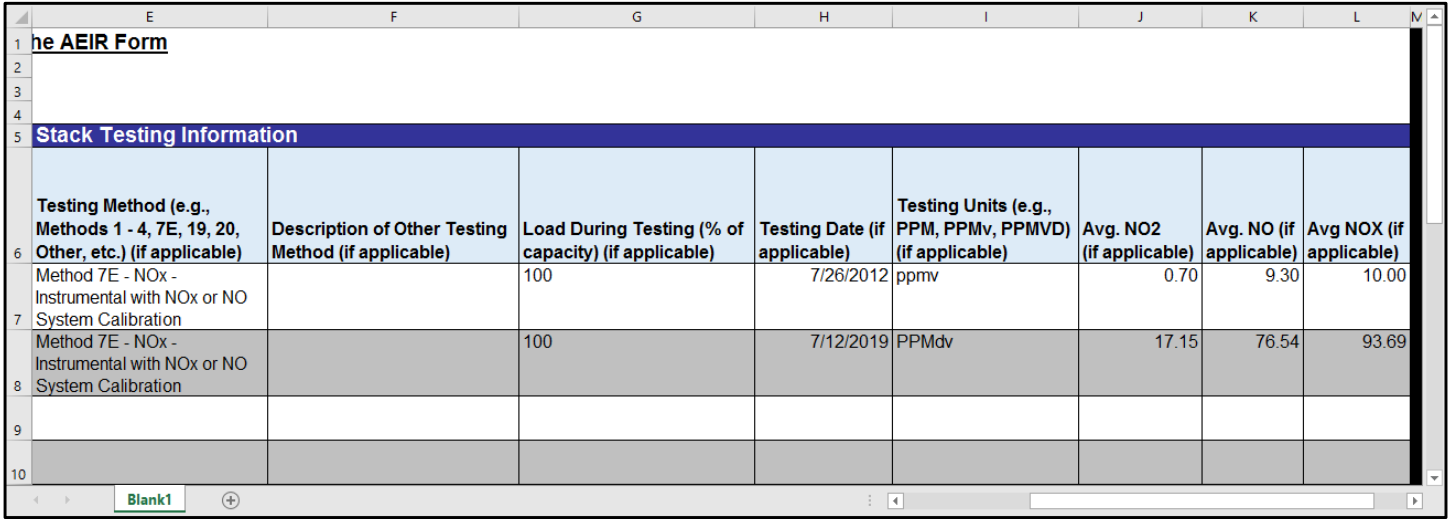- Air Homepage
- Alberta Air Quality
- Prevention of Air Pollution
- Consistency in Data Quality
Verifying Consistency in Data Quality for the Alberta Annual Emissions Inventory
An Annual Emissions Inventory Report (AEIR)'s final step, outlined in Section 17, is to demonstrate consistency in data quality and make sure the emissions data included in the report accurately reflects an industrial operation's environmental impact. See a list of the previous steps.
 Make sure your air reporting is compliant...with expert AEIR guidance!
Make sure your air reporting is compliant...with expert AEIR guidance!What could make this text interesting to you?
- You are in charge of an industrial facility that must comply with regulations and submit accurate reports.
- You are looking for environmental consultants who can prepare these reports for industries.
- You work for a regulator that oversees air quality and emissions.
- Your goal is to understand how industrial facilities make sure their environmental impact data is accurate.
Here's how to verify emission totals based on past reports and what's expected. We'll also talk about how to explain significant changes in emissions and record any changes to how emissions are measured.
Additionally, you have to report any major operational changes that affect emissions. Finally, the text explains how to include voluntary comments and/or data about the conversion of nitrogen dioxide (NO2) to nitrogen oxides (NOX).
17.0 Other information to report
Back in Step 16c, you report normal emission rates for specific substances. The emissions are reported in tonnes/day for release points under typical operating conditions. Quantification methods are also documented. Understanding emissions' behavior under normal conditions and assessing their impact on the environment are important steps.
17.1 - Check the totals for Schedule 1 substances
If you're concerned about consistency in data quality, check the total emissions of certain substances in an industrial operation in this step. In a worksheet, you look at the annual, normal, and maximum emissions. It's just a check to see if the numbers make sense.
You ask questions like:
- How do you feel about the emission totals for different substances?
- Are they the same as past reports?
- You consider these things for normal emissions:
When compared to annual and maximum rates, do these rates make sense? - You check if they're higher than normal and if they're annual.
By doing this, you'll make sure the emissions are accurate and consistent.
17.2 - Explain significant changes in emissions to show consistency in data quality
This step requires you to explain any significant changes in your industrial operation's emissions of certain substances. It's only required if the total annual actual emissions of a substance (Schedule 1 or Schedule 2) changed by more than 10%. Just explain changes in annual actual emissions, not normal or maximum emissions.
Here's what you have to do:
Identify changes: Check if there were any changes in Schedule 1 or Schedule 2 emissions over the previous year. And if there were changes, explain why they happened to display consistency in data quality. An increase in NOX emissions from increased power generation output, for example, would be explained.
By doing this, you can help regulator can why emissions have changed so much.
17.3 - Describe authorized changes to the method used
Explain any changes you made to the way you measure or estimate emissions from the previous year. You can't make these changes without the director's approval.
Here's what you have to do:
- Make sure there haven't been any authorized changes to how you measure or estimate emissions.
- If there were changes, describe them.
- For example, you'd explain if you got permission to use a different method for calculating NOx emissions, resulting in a 25% increase.
Any changes to how you measure emissions need to be documented and approved to maintain consistency and reliability. Changes that aren't authorized aren't allowed.
17.4 - Describe any significant changes to your operations
If any changes or modifications to your industrial operation affected air emissions during the year, you need to report them here. You can do it this way:
During the year, check if any changes or modifications were made to your plant or operations that affected air emissions.
If there were significant changes, describe them. As an example, if you brought new equipment online in phase two of your development, increasing emissions of substances like NOx and CO, you'd explain it.
Make sure any major changes to your operation that could affect emissions are documented and reported. Maintaining accurate emissions reporting means tracking such changes.
17.5 - Describe your efforts to reduce emissions
In this step, you need to report any steps you took to reduce air emissions at your industrial operation. You can do it this way:
Determine if your industrial operation took any steps to reduce air emissions last year. Describe your actions: If you took any, describe them. You'd explain this change if you changed your process to remove more metals before they reach the main stack, so your selenium emissions were reduced.
Show your commitment to minimizing environmental impact by highlighting your efforts to reduce emissions. Transparency and environmental responsibility require tracking these actions.
17.6 - Describe your thoughts and provide any additional information you have
Here's where you can add any extra comments or information about your Annual Emissions Inventory Report (AEIR):
If you have any comments or extra details which might help you show how you maintained consistency in data quality, add them to your AEIR. If you have anything to add, put it here. You could mention that your AEIR was prepared by environmental consultants and reviewed by your internal staff.
Adding extra context and details to your AEIR ensures transparency and completeness.
17.7 - Please report any additional information the Director wants
Using the info in Clauses EIS 17-A and B, you can provide additional voluntary information about NO2/NOX in-stack ratios for certain emissions in this step:
 Get ready for Simulations of Air Quality
Get ready for Simulations of Air QualityThe government might ask about how much NO2 and NOX emissions come from different places at your facility. Modeling air quality requires this information. You can report this information voluntarily, but it's strongly recommended if you have it. Here's what you can do:
- Copy the release point number from the AEIR form.
- Descriptive Name: Type the name of the release point (copy from AEIR).
- Report NO2/NOX in-Stack ratio as a decimal.
Explain where the ratio data came from (e.g., stack testing).
If testing was done, mention the method (e.g., EPA Methods 1 - 4). - Other Testing Method (if applicable): Only if you picked "Other.".
- If testing was done, specify the load during testing (percentage of capacity).
- Provide the date of the test (if applicable).
- Units of testing (if applicable): State what units you're testing with (e.g., PPM, PPMv).
- Average. Report the average NO2 concentration if you tested it.
- Average. If you tested for NO, report the average concentration.
- Average. If you tested for NOX, report the average concentration.
It helps with air quality modeling and regulatory decisions. Reporting is voluntary, but strongly recommended if you have the data. Here is an example:
 The information to enter in sample columns.
The information to enter in sample columns.17.8 - Fill out extra sheets if you have any other emission rates to note
You don't have to report any additional emissions via extra worksheets for 2022, 2023, or 2024. In the future, these worksheets might be needed to report emissions for more substances if the Director wants them.
17.9 - Use the blank sheets to report any additional NO2 info
You can use blank worksheets in the AEIR Form, but only report NO2/NOX in-stack ratios for 2022-2024. Don't use them otherwise unless instructed, as the Regulator won't automatically import info.
Expert help for your annual emissions inventory report
Are you having trouble with Alberta's Annual Emissions Inventory Report (AEIR)? Calvin Consulting Group Ltd. can guide you through the process. Our comprehensive AEIR submission consulting service ensures compliance and avoids costly delays.
Calvin Consulting Group: Why Us?
- Environmental experts: Our team understands the intricacies of EPEA and AEIR.
- We guide you through every step, making sure data is accurate and consistent.
- Reduced workload: Let us handle AEIR complexities so you can focus on core operations.
- Get peace of mind knowing your report is compliant.
Don't let AEIR compliance get you down. Get a free consultation from Calvin Consulting Group! Get in touch with us at...

...to see how we can simplify your AEIR submission.
Clean air is our Passion...Regulatory Compliance is our Business.
An industrial operation must ensure consistency and accuracy in the data it reports for its Annual Emissions Inventory Report (AEIR).
Verifying emission totals, explaining significant changes, and documenting adjustments to measurement methods or operational changes that may affect emissions are all covered here.
Do you have concerns about air pollution in your area??
Perhaps modelling air pollution will provide the answers to your question.
That is what I do on a full-time basis. Find out if it is necessary for your project.
Have your Say...
on the StuffintheAir facebook page
Other topics listed in these guides:
The Stuff in the Air Site Map
And,
Thank you to my research and writing assistants, ChatGPT and WordTune, as well as Wombo and others for the images.
GPT-4, OpenAI's large-scale language generation model (and others provided by Google and Meta), helped generate this text. As soon as draft language is generated, the author reviews, edits, and revises it to their own liking and is responsible for the content.



New! Comments
Do you like what you see here? Please let us know in the box below.